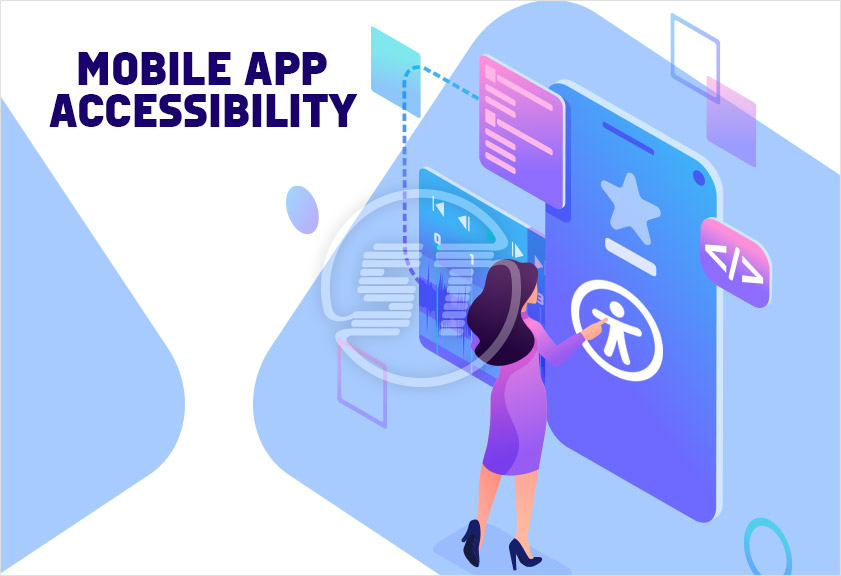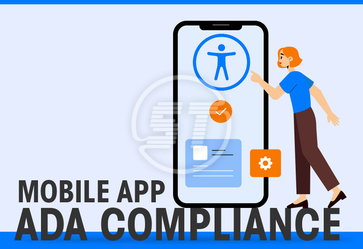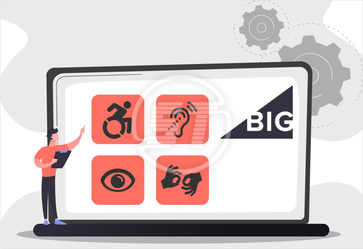With increasing mobile usage, people are relying more on mobile apps instead of logging on to websites. When the demand for mobile apps is soaring, their design ought to make the application accessible for everyone including people with disabilities.
To make all the mobile apps accessible, the laws have put them under the vigilance of ADA guidelines. The apps are a part of ADA’s protected ‘place of public accommodation.’ Mobile apps are evolving daily, and accessibility is one of the top features for mobile applications.
Mobile app accessibility implies complete access to create, collaborate, and communicate. Mobiles are made now-a-days keeping people with some physical or cognitive disabilities in priority. Therefore, the current scenario put developers on their toes to create accessible apps for each mobile, either Android or iOS. The application must be compatible for the mobile platform to offer consistent performance and adhere to the laws.
An application that is being developed for a specific mobile operating system (Android or iOS) is called Native Mobile Application. These native apps perform better on the specific platform because they are made of the same software language as the mobile is made up of. And they allow developers to access all the features of a particular mobile such as, camera, GPS, hardware, etc.
With ADA compliant mobile apps, there are a multitude of benefits like increasing the size of your target user base, improving your brand reputation in the market, universal accessibility, improved usability, increased downloads, ROI, etc.
Native mobile applications with ADA and other guidelines
All the native mobile applications ought to be compliant with ADA, section 508 of the Rehabilitation act and W3C-WAI guidelines. The government and federal-funded schools and organizations’ applications come under section 504/508 and other private entities’ apps fall under ADA criteria. So, every mobile application must adhere to these guidelines for complete accessibility and vanish the chance of discriminating against specially abled people.
Native mobile application development implies creating an app for a specific operating system (as written above), considering the platform’s peculiarity and languages. Such native apps are made for the compatible platform’s app stores only. There are application development tools available for both Android and iOS (like Android Studio, XCode, AppCode, etc.). These tools help to enhance the native mobile app accessibility.
Tips to build an ADA accessible native mobile application
Mobile apps are an inseparable part of our lives. People use them irrespective of their age, gender, and physical disabilities. Now educational needs are also associated with these mobile apps. So, to make every app accessible to each person, you ought to abide by the laws to make your apps under WCAG / ADA guidelines.
Here are the tips to develop an accessible native mobile application:
Provide an alternative to text typing
There are some users who face problems while typing long text. For such people, the application includes features like auto-filling known information, checkboxes, select menus, etc. It will reduce the time of typing and make surfing easier for them.
Design the app considering various screen sizes
The screen size must be a point to look over carefully. The content should appear aptly in all screen sizes. There should be limited information on each page and zooming in must work for people who have poor vision.
Link text length must adapt to the viewport width. It can position form fields below their labels instead of placing them beside each other. It will make the form easy to read on mobile.
Touch targets must be in the right place
The use of interactive elements in an app is inevitable and high-resolution mobiles allow them to appear together on small screens. But these elements should be distant enough so that users can target them easily.
The touch targets ought to be big enough for people with vision or cognitive impairments to perform the task without any issue. Touch targets should be 9mm high and 9mm wide. Also, the interactive elements should be visible readily.
Use native components
Native components are familiar with the platform and hence help to create an accessible app for that platform. These components enable appropriate features to make the app accessible to every mobile user. Take note to use the components as they are intended to provide logical and undisrupted flow to achieve accessibility.
Implement Hamburger menus and accordions correctly
If the design components hamburger menus (it is three stacked horizontal lines positioned on the extreme left or right on the mobile screen) and accordions (a design element that gets enlarged to display hidden element) used wrongly, they can cause disturbance to visually disable people. Thus, ensure to use these components correctly to avoid the mess.
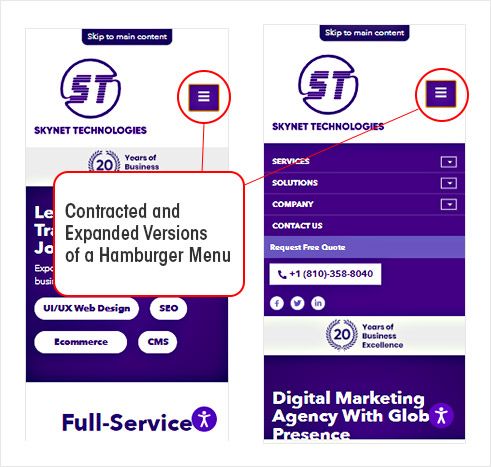
Include pinch-to-zoom tool
This is a feature that helps visually impaired people to zoom in on the content whenever and wherever they wish to, by using two finger gestures. It expands the text and images and provides a clear visual.
Use of Dynamic type
Dynamic type is a feature of a native mobile app that allows users to choose the size of the textual content. It assists the users who need larger texts for better readability. Apps that use dynamic type offer more consistent reading experience to users as per their choice.
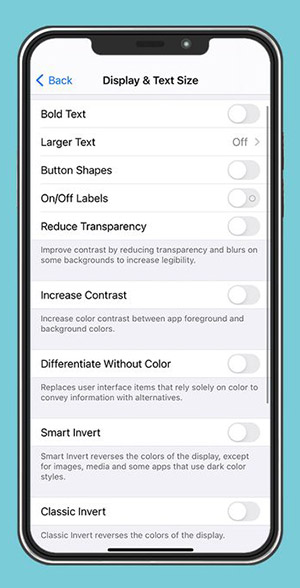
Mobile keyboard usability enhancement for input types
To avoid the irritating taps for a single entry and to provide a smooth user experience, use input type. For example: you can provide Text input type to reduce the typing work. It will give ideas to auto-fill the sentence. While entering emails, keyboard should show @ and .com to enter the email easily. If a numeric entry is needed, then the number keyboard should appear. To enter the password, the virtual keyboard is a help in reducing the mistakes. Using the handy mobile keyboard, user can start the search just tapping on the go button, because there ‘go’ reads as ‘search,’ and many more input types can be added.
Thus, provide input type to vanish the mess of typing errors and to increase the user experience.
Layouts should be consistent
Some components appear on each page of the mobile app; those components should appear in a consistent layout on every page of the app. The native mobile apps must follow consistency for repeated components and navigational elements.
For instance, if an app has a logo, title, search panel, and navigation bar, it should appear in the same sequence on every page of the app, regardless of the mobile orientation (portrait or landscape).
Check the color contrast
WCAG has a specific criterion for text and background color contrast for web and mobile applications. The app developers must be more careful while developing native mobile apps because people use mobiles in different lights at distinct locations. If they are using the device in sunlight or a brighter lighted area, then people with some vision issues might face problems exploring the app.
Although good contrast is critical for everyone, it badly ruins the UX for visually impaired people. Text legibility given by WCAG 2.1 AA conformance is, that color contrast must be at least 4.5:1 and for larger text 3:1 to make the text clearly readable.
The design ought to be color compliant for color blind people as well. A significant number across the world fall into color blindness disorder. Color blindness affects how people perceive your app. So, if the app is using colors (especially red and green because many people have an issue with these two colors), it should provide an alternative to indicate what colors they are.
Multimedia must have a transcript
An app may contain audio and videos for a better user experience, but it may ruin the experience for people with some hearing issues. The video must have closed captioning to make it understandable and audios should have a full-text transcript. The native mobile app needs to include these guidelines to become ADA compliant. Furthermore, the caption should be coordinated with whatever happens on the screen to avoid confusion.
Error messages must be clear and comprehensive
If a user is filling out a form or submitting some data, there should be clear instructions to fill in the form or if they are making mistakes, error messages should appear in the correct format. As mentioned above, avoid using red and green colors for error messages. The error message must be encoded properly so that screen readers can understand the message.
This way, it will provide a smooth execution of the app to people with disabilities.
Both iOS and Android provide accessibility features such as text-to-speech, haptic feedback, gesture technologies, etc. Visually impaired people use Voiceover on iOS and Talkback on Android. Apple has Zoom and Android has Lookout which is a magnifying digital lens for visually impaired people to read and understand the text and color. Google Assistant and Voice Access provide hands-free and voice command usability. To make a native mobile app you should use these specific features in your app and make it utterly compliant.
Auditing/testing of the native mobile app
Once you are done with the design and development of your native mobile app, the app must be gone through ADA and WCAG testing for its accessibility. Though the app development tools keep on checking the errors and rectifying them during the development phase itself, final testing is necessary.
Ensure the manual testing should done by a qualified auditor who can help you in finding the genuine issues. The auditing or testing must run in a loop to ensure the consistency of the app.
Make sure to add the above-mentioned critical features in a native mobile app to make the app ADA compliant.
Wrapping it up
For some reason, many native mobile apps are still not complaint to ADA guidelines. Implementing the best practices like mobile gestures, color contrast, touch targets, etc. is not difficult. In fact, it saves your app from being called an illegal app and gains more users. Inclusion and acceptance are not only required in our actions but also in technology. It is a basic right of everyone that they can access every available resource including mobile and its applications.
Build mobile applications for iOS and Android platforms with fully compliant ADA accessibility features to improve the usability and accessibility for people with disabilities. We provide complete ADA compliance mobile app development services including existing application ADA compliance, redesigning of your application with ADA compliance, new ADA compliance mobile app, ADA compliance ecommerce application, and more. Get in touch with us at hello@skynettechnologies.com or submit the following request free quote form.
